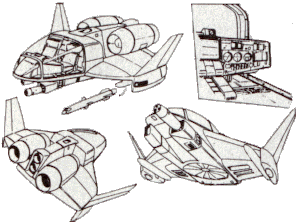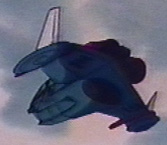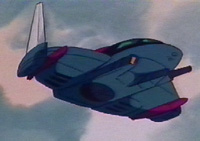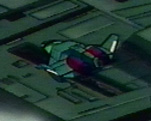

Designation:ARV-15A/B Bumblebee Reconnaissance VTOL Aircraft |

|
||||

|
|||||


WARNING: DRAFT Material! - Revised based on the discovery of animation sheets.

| Total Length: | 7.3 m |
| Total Height: | 2.6 m |
| Total Wingspan: | 6.6 m |
| Total Dry Weight: | 8.9 metric tons |


The skin of the Bumblebee is composed of treated steel plate. The skin stops all small arms fire, provides good protection against heavier infantry weapons, such as a 12.7mm machinegun round, and poor to fair resistance to light mecha-mounted weaponry, such as the Zentraedi 22.3mm HE autocannon round.
The Bumblebee provides full protection from nuclear, biological, and chemical hazards, using an overpressure cockpit environment activated by radiation and hazardous chemical sensors, or manually when biological warfare conditions are anticipated. The internal consumables supplies can provide atmosphere for one day maximum.

The Bumblebee was developed to provide a small, agile, reconnaissance vessel in support of the ground infantry of the Tactical Corps. This craft could be considered an advanced cross of a hovercraft and a helicopter with the 'main rotor' embedded within the rear hull of the lifting body. This arrangement better protected the vulnerable rotor while providing for better survivability in case of rotor failure. This better survivability is due to the standard engines and lifting body that would allow significantly improved gliding and flight capabilities, yet the counter-rotating fan blades could still provide some autorotation capabilities to reduce the impact. The outboard engines and winglets provide the yaw control that the tail rotor previously provided, with the counter-rotation providing rotational stability. Due to the improved aerodynamics, the Bumblebee was capable of breaking the sound barrier if it was needed to rapidly deploy or escape. The main engines utilize fusion plasma to superheat the air entering the intakes. This provides an operating range that is only limited by the protoculture power systems needed to start and contain the fusion reactions. To achieve these speeds, secondary plasma shock thrusters provide the additional needed thrust.
The Bumblebee is loaded with sensor equipment. The primary arrays are located on the underside to the right of centerline symmetric with the 25mm autocannon. Additional sensors are embedded in the leading edge of the wing and on the dorsal area. To maximize sensor loading, armor was sacrificed and the Bumblebee relies on its speed and agility for survival.
The Bumblebee frequently provided forward close air reconnaissance during ground operations as provided by the Tactical Corps' Reconnaissance divisions for the other arms of the Army of the Southern Cross. The -B variant of the Bumblebee was devised to support limited anti-submarine warfare missions as well as better patrol the coastal and seaways, with an appropriate loadout on the hardpoints and the attachment of a sonar pod to the central axle of the lift fan rotors.
Return to Southern Cross Aircraft Index.
Go to Robotech Reference Guide Home Page.
Robotech (R) is the property of Harmony Gold. This document is in no way intended to infringe upon their rights.
Content by Robert Morgenstern, with Pieter Thomassen and Peter Walker